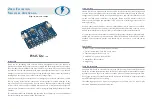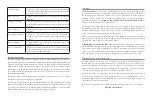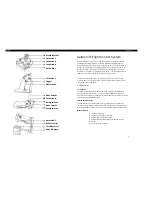
Description of EVMS Lite connections
Terminal name
I/O
Description
12V
Input
To 12V battery positive (permanent supply, not key
switched). Approx 9-18V maximum range.
Ground
Input
To vehicle chassis, or 12V battery negative.
Key in
Input
To key signal, should be +12V when key is turned on
Charge In
Input
Connect to your charge detection switch, such as a fuel
door switch or 240V detect relay/circuit. Should pull to
ground when the switch is on (so attach other side of
switch to chassis, near the switch is fine).
LED
Output
Allows for wiring of a remote LED for viewing status in
cabin. 5mA limited. Connect this pin to LED anode, and
cathode to ground/chassis.
Buzzer
Output
Connect a 12V piezo buzzer to this output pin for an
audible warning when errors are detected.
Drive
Output
Supplies 12V to the main contactor, precharge system or
motor controller while the key is on and the BMS reports
no errors.
Aux Ctr
Output
Supplies 12V to any auxiliary contactors you may have
such as pack break-up contactors, while either driving
or charging.
Charge
Output
Supplies
CAN Bus Wiring
The EVMS Lite also has two CAN bus ports (5-pin Molex
C-Grid SL) on one side of the case. These are wired
identically, and can be connected in either order in any
location along the CAN bus. (The EVMS Monitor and
BMS12 modules use the same 5-pin plugs and wiring.)
12V
CAN H
CAN L
Gnd
Shield
CAN pin assignments on 5-pin plugs
CAN buses work best when wired as a single daisy chain of devices, with 120ohm termination
resistors at each end to prevent signal reflection. For this reason all ZEVA CAN-enabled
devices have dual CAN ports for easy daisy-chaining. The order of devices is unimportant -
usually the shortest path between devices is best.
For the sake of noise immunity, CAN buses typically use twisted pair cable. Since electric
vehicles can involve high electromagnetic interference (EMI) from the traction circuit, we
recommend using shielded twisted pair (STP) wire for maximum noise immunity. Very short
connections are usually OK with untwisted and/or unshielded cable.
EVMS Monitor
The EVMS Monitor is used to remotely interact with other devices on the CAN bus, both
for viewing operating data and to edit settings. The Monitor has various different pages of
information as described below.
EVMS Lite
System Idle
The default display when the vehicle is idle (neither
driving nor charging).
In order to minimise quiescent power consumption
while the vehicle is not in use, the EVMS Lite will
power down the CAN bus after 1 minute in idle state.
You can use this time window to enter Options and
Settings modes.
EVMS Lite: Running
Pack voltage # Cells
Min voltage Max voltage
M0 C4 M2 C8
149.4V 45
3.31V 3.33V
The standard display when the vehicle is runnng or
charging, showing the pack voltage (total of monitored
cells), total number of cells, and the voltage and
location of both the lowest and highest cells.
Along the bottom is a bar graph showing all cells being
monitored. Green bars indicate cells within range. Bars
will change to blue for undervoltage cells, orange for
cells being balanced, and red for overvoltage cells.
BMS Details: Module 1
Cell voltages
3.32V 3.33V 3.32V 3.31V
3.33V 3.31V 3.32V 3.32V
3.31V 3.32V 3.33V 3.32V
3.32V 3.32V 3.33V 3.31V
Temp1: 23˚C Temp2: 25˚C
Prev Next
Detailed information for a single BMS module,
showing voltage of each cell (to 2 decimal places) and
two temperatures if available. Orange bars beneath
the voltages indicate if cell shunts are currently on.
Touch within the Prev and Next buttons to change
which BMS module is being viewed, or anywhere else
in the display to change Monitor pages.























